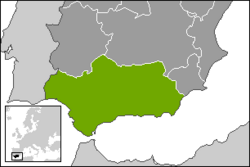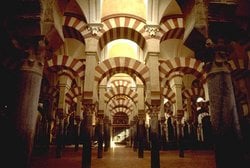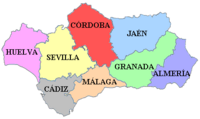Andalusia
| |||||
| Motto: Andalucía por sí, para España y la humanidad (Andalusia by herself, for Spain, and for humankind) | |||||
| Anthem: La bandera blanca y verde | |||||

| |||||
| Capital | |||||
| Official language(s) | Spanish | ||||
| Area – Total – % of Spain |
Ranked 2nd 87,268 km² 17.2% | ||||
| Population – Total (2006) – % of Spain – Density |
Ranked 1st 7,975,672 17.84 91.39/km² | ||||
| Demonym – English – Spanish |
Andalusian Andaluz, andaluza | ||||
| Statute of Autonomy | December 30 1981[1] | ||||
| Parliamentary representation – Congress seats – Senate seats |
62 40 | ||||
| President | Manuel Chaves González (PSOE) | ||||
| ISO 3166-2 | AN | ||||
| Junta de Andalucía | |||||
Andalusia (Spanish: Andalucía) is an autonomous community of Spain. Andalusia is the most populous and the second largest, in terms of its land area, of the seventeen autonomous communities of the Kingdom of Spain. Its capital is Seville.
Andalusia is bounded on the north by the autonomous communities of Extremadura and Castilla-La Mancha; on the east by the autonomous community of Murcia and the Mediterranean Sea; on the west by Portugal and the Atlantic Ocean; on the south by the Mediterranean Sea, the Strait of Gibraltar, which separates Spain from Morocco, and the Atlantic Ocean. The British overseas territory of Gibraltar shares a three-quarter-mile land border with the Andalusian province of Cádiz at the eastern end of the Strait of Gibraltar.
History
Tartessians and Phoenicians
Tartessos, home of the once-powerful Tartessian civilization, was founded in Andalusia in pre-Roman times. The Phoenicians colonized several areas on the Andalusian coast during the latter part of the second millennium B.C.E. The most important settlement was Cadiz (Gdr or Gdz in Hebrew) around 1100 B.C.E.
Carthaginians and Romans
With the fall of the Phoenician cities, Carthage became the dominant sea power in the western Mediteranean and the most important trading partner for the Semitic towns along the Andalusian coast. Between the first and second Carthaginian wars, Carthage extended its control beyond Andalusia to include all of Iberia except the Basquelands. Andalusia was the major staging ground for the war vs Rome led by the Barkid Hannibal. The Romans defeated the Carthaginians and conquered Andalusia, the region being renamed Betica.
Vandals and Visigoths
The Vandals moved briefly through the region during the 5th century CE before settling in North Africa, after which the region fell into the hands of the Kingdom of the Visigoths who had to face the Byzantine interests in the region.
Arabs and Moors
The Umayyad Caliphate invasion of the Iberian peninsula in 711-718 marked the collapse of Visigothic rule. Andalucian culture was deeply influenced by half a millennium of Muslim rule during the Middle Ages. Córdoba became the largest and richest city in Western Europe and one of the largest in the world. The Moors established universities in Andalucia, and cultivated scholarship, bringing together the greatest achievements of all of the civilisations they had encountered. During that period Moorish and Jewish scholars played a major part in reviving and contributing to Western astronomy, medicine, philosophy and mathematics. With the fall of Seville in 1248 most of Andalucia came under Castilian control, leaving only the emirate of Granada under Muslim rule until it too was conquered by the Catholic monarchs, Ferdinand and Isabella in 1492. The largest Arabic speaking population was in Andalucia, which also received Moors from other regions who were driven south by the Reconquista, and although many either converted or left later, they gave the region its distinctive character till this day.
Andalucia is known for its Moorish and Moorish influenced architecture. Notable examples include the Alhambra in Granada, the Mezquita in Córdoba, the Torre del Oro and Giralda towers. Other architectural styles include Mozarabic, such as the Reales Alcázares in Seville, and the Alcazaba in Málaga. Archaeological ruins include Medina Azahara, near Córdoba, and the Roman city of Itálica, near Seville, and at Palos, in the province of Huelva, the Andalusian port from which Columbus's expedition of discovery was launched.
The Spanish language spoken in the Americas is largely descended from the Andalusian dialect of Spanish. Although, the Spanish spoken at the Canary Islands resembles more the Spanish spoken in the Caribbean. This is due to the role played by Seville as the gateway to Spain's American territories during the sixteenth and seventeenth centuries.
Andalusia Day (in Spanish, Día de Andalucía) is celebrated on February 28, to commemorate the date of the successful referendum vote on autonomy.
Geography
Administrative divisions
| Province | Capital | Population | Density | Municipalities |
|---|---|---|---|---|
| Almería | Almería | 635.850 | 72,47 hab./km² | Municipalities |
| Cádiz | Cádiz | 1.180.817 | 158,80 hab./km² | Municipalities |
| Córdoba | Córdoba | 788.287 | 72,47 hab./km² | Municipalities |
| Granada | Granada | 882.184 | 68,70 hab./km² | Municipalities |
| Huelva | Huelva | 483.792 | 47,67 hab./km² | Municipalities |
| Jaén | Jaén | 662.751 | 49,09 hab./km² | Municipalities |
| Málaga | Málaga | 1.491.287 | 204,06 hab./km² | Municipalities |
| Seville | Seville | 1.813.908 | 129,23 hab./km² | Municipalities |
Other important Andalusian cities are:
- El Ejido, and Roquetas de Mar, Almería
- La Línea de la Concepción, Algeciras, Sanlúcar de Barrameda, Rota, San Fernando, Jerez, and El Puerto, Cádiz
- Almuñécar, Guadix, Loja and Motril, Granada
- Linares, Úbeda and Baeza, Jaén
- Antequera, Ronda and Marbella, Málaga
- Dos Hermanas, Lebrija, Osuna and Utrera, Sevilla
Economy
According to the Spanish Instituto Nacional de Estadística, the GDP per capita of Andalusia (17.251 €, 2006[citation needed]) is still one of the lowest in Spain. At the same time, the manufacturing and service sectors have grown at a higher rate than in Spain and the rest of the Eurozone. This growth rate is expected to continue.[citation needed]
Transports and commerce
The main road in the region is the European Route E15
Government and Politics
The Autonomous Comunitie of Andalusia is administrated through the "Junta de Andalucia" and is one of the 4 historic Autonomous Communities of Spain. It has a local parliament and president.
Monuments
Native or Famous people from Andalusia
- Abu al-Qasim al-Zahrawi
- Alejandro Sanz
- Antonio Banderas
- Antonio Gala
- Averroes
- Blas Infante
- Camarón de la Isla
- Carmen Sevilla
- Chiquito de la Calzada
- David Bisbal
- Diana Navarro
- Estrella Morente
- Diego Velázquez
- Federico García Lorca
- Felipe González
- Gustavo Adolfo Bécquer
- Isabel Pantoja
- Jean Reno
- Lola Flores
- Maimonides
- Manuel de Falla
- Pablo Picasso
- Paco de Lucía
- Rocío Jurado
- Rosa López
- Seneca the Younger
- Trajan
see also Cat:Andalusian people
See also
- Andalusian people
- List of Andalusians
- Andalusian nationalism
- Music of Andalusia
- Andalusian cuisine
- Canal Sur
Notes
- ↑ The Statute of Autonomy for Andalusia was approved by "Ley Orgánica 6/1981, de 30 de diciembre, Estatuto de Autonomía para Andalucía", published in Boletín Oficial del Estado n. 9, 11 January 1982. As for "Decreto Ley 11/1978" a provisional Autonomous Government (Junta de Andalucía preautonómica) had already been created. The Statute of Autonomy has been reformed in 2006, and the amended text approved by the Senate of Spain and the Congress of Deputies of Spain. The new Statute will be voted on in a referendum in 2007.[1]
Sources and further reading
External links
- Official Tourism Website of Andalusia
- History of the Andalusian Flag
- Andalucia Photo and History Pages
- FiestasdeAndalucia.com Fairs and traditional fiestas of Andalusia
| |||||||||
| |||||||
Credits
New World Encyclopedia writers and editors rewrote and completed the Wikipedia article in accordance with New World Encyclopedia standards. This article abides by terms of the Creative Commons CC-by-sa 3.0 License (CC-by-sa), which may be used and disseminated with proper attribution. Credit is due under the terms of this license that can reference both the New World Encyclopedia contributors and the selfless volunteer contributors of the Wikimedia Foundation. To cite this article click here for a list of acceptable citing formats.The history of earlier contributions by wikipedians is accessible to researchers here:
The history of this article since it was imported to New World Encyclopedia:
Note: Some restrictions may apply to use of individual images which are separately licensed.




